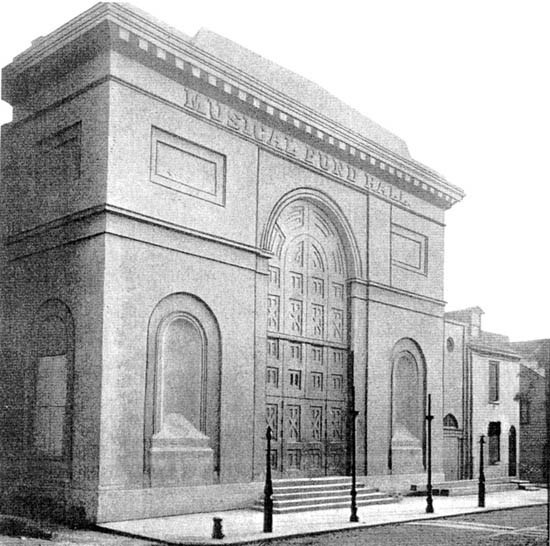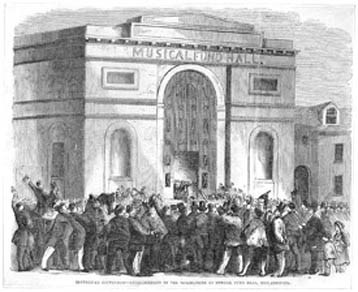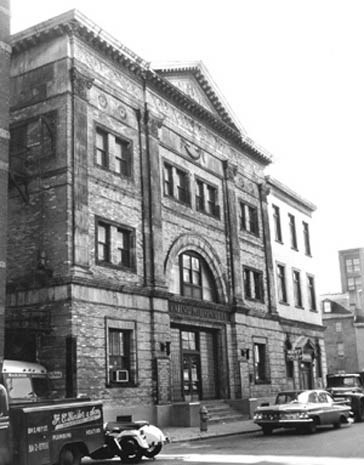
Photograph courtesy of Centenary, Musical Fund Society of Philadelphia, 1820-1920.
Musical Fund Society Hall
Philadelphia, PA
Designated an NHL: May 30, 1974
Designation withdrawn: January 13, 1989
The Musical Fund Society was founded in 1820 to formalize ongoing gatherings of Philadelphia amateur and professional musicians. It was incorporated in 1823 with the purpose of "the cultivation in skill and diffusion of taste in music and the relief of decayed musicians and their families." Performances were held at a number of locations for several years, but in 1824 the Society purchased the Fifth Presbyterian Church on Locust Street to establish a permanent venue for performances. Architect William Strickland, a society member, designed the alterations to the church and the Musical Fund Hall was opened in December 1824. The Hall was described in a newspaper review of the first concert:
"The room is exceedingly neat, and its decoration does honor to the taste of Mr. Strickland, an architect of whom Philadelphia may be justly proud. It is one hundred and six feet long, sixty feet wide, and twenty-six feet high, and is admirably calculated for the conveyance of sound..."
Alterations were first made in 1847, under the supervision of two Society members, Napoleon LeBrun, an architect, and Franklin Peale, an artist. Detailed in the Society's report of that year, the changes included extending the front of the building by sixteen feet and moving the stage to the rear of the building.
The Musical Fund Hall was host to world renowned performers during the first half of the nineteenth century. Famous musicians such as the Scandinavian violin virtuoso Ole Bull, who first performed here in 1848, and renowned pianists such as Louis Gottschalk, Kossowski, Sigismund Thalberg, and Wolfsohn appeared at the Hall. Notable vocalists performing at the Hall included Madame Malibran in 1827, Jenny Lind, ‘the Swedish Nightingale' in 1850 and 1851, and Henrietta Sontag and Adelina Patti in 1852.

Engraving courtesy of Ballou's Pictorial Drawing-Room Companion, June 1856.
In 1856, the Musical Fund Hall became a stage for national politics, hosting the first national convention of the fledgling Republican Party from June 17th to 19th. The Republican delegates were united by their opposition to the extension of slavery into the western territories. They nominated John C. Fremont as the party's presidential candidate. Only 43 at the time of his nomination, Fremont had limited political experience, but was well-known for his exploratory crossings of the Rocky Mountains and for his role in gaining California for the United States. The Republican platform was embodied in the slogan "Free Soil, Free Speech, Free Men, Fremont and Victory." Fremont narrowly lost the election to the Democratic candidate, James Buchanan.
In 1857, the Philadelphia Academy of Music opera house, also designed by Napoleon Lebrun, opened with a seating capacity of 3,000. It quickly superseded the Musical Fund Hall as the venue for the foremost talent performing in Philadelphia. The opening of the Academy had a detrimental effect on the number and nature of performances held in the Hall. Philadelphia architect Addison Hutton supervised a second remodeling in 1891. The interior was redecorated in Victorian style and divided into three saloons and a banquet room; Hutton added a story to the building and created the existing facade in 1893.
By 1908, social and athletic events were more common in the Hall than musical performances. In 1924, the building was sold to the Philadelphia Labor Institute, but the Society repossessed the property and rented it to a boxing promoter from 1937 to 1942. The building was again sold in 1946, to Yahn and McDonnell, a cigar company. The interior was converted to a warehouse and the entrance was altered. During ownership by this company, the auditorium was evidently used as an enormous humidor, capable of storing 2,500,00 cigars. The Musical Fund Hall was purchased by the Philadelphia Redevelopment Authority in 1964 but was unoccupied while a purchaser interested in restoration was sought.
The Musical Fund Society Hall was listed in the National Register of Historic Places on March 11, 1971. On May 30, 1974, the building was designated a National Historic Landmark in recognition of its national role in musical and political history. The Hall was one of the oldest extant music halls in the United States and the home of the Musical Fund Society, an early and influential organization in music. It was also the scene of the first national convention of the Republican Party. The second floor auditorium and balcony were deemed essential to the national significance of the building, as this is where important musical performances and events of the 1856 Republican convention occurred.

NPS Photo
While the building was unoccupied, deterioration occurred. In 1979 several roof trusses and part of the roof collapsed, damaging the west wall of the building. Water damage also caused significant deterioration to the auditorium. In 1980, the City of Philadelphia cited the Musical Fund Society Hall as an "imminently dangerous building." In order to preserve the building, the city sought and found a developer who would adapt it for residential reuse. After 1981, it was converted into condominiums. This conversion to residential use necessitated the elimination of the auditorium, thereby eliminating the features for which it had been deemed nationally significant. At the time, this conversion and the resulting loss of its nationally significant qualities was viewed as the only means to save the building from demolition. As a result of these changes, the Landmark designation for the Musical Fund Society Hall was withdrawn on January 13, 1989. The building continues to be listed in the National Register of Historic Places.
Last updated: August 29, 2018
